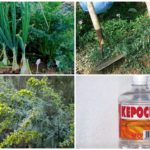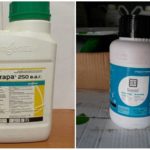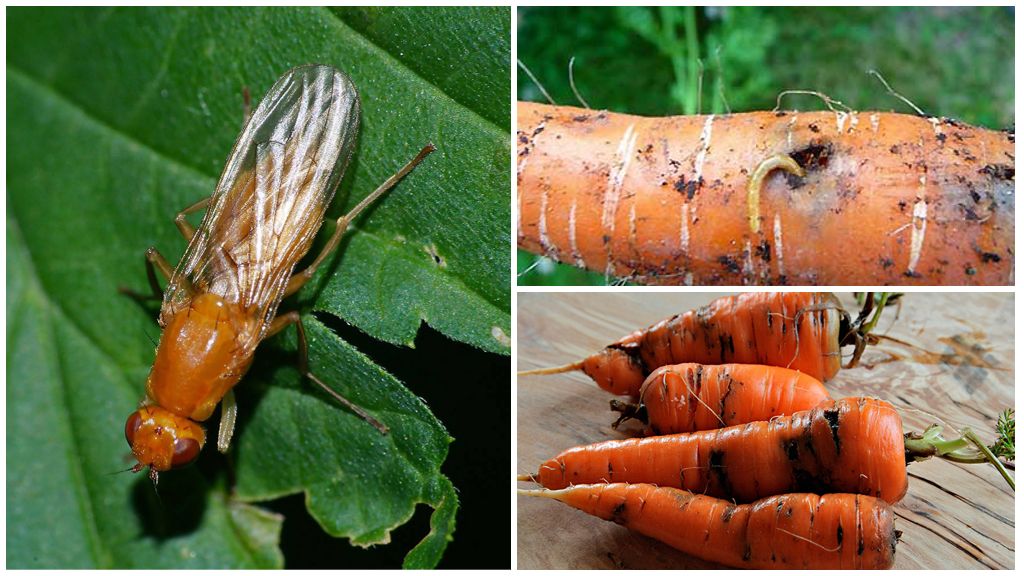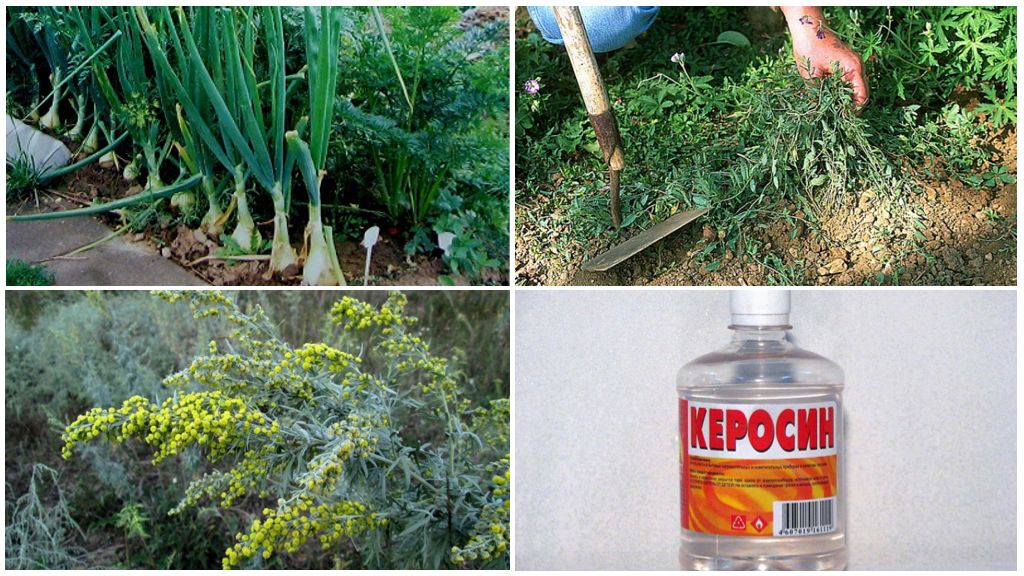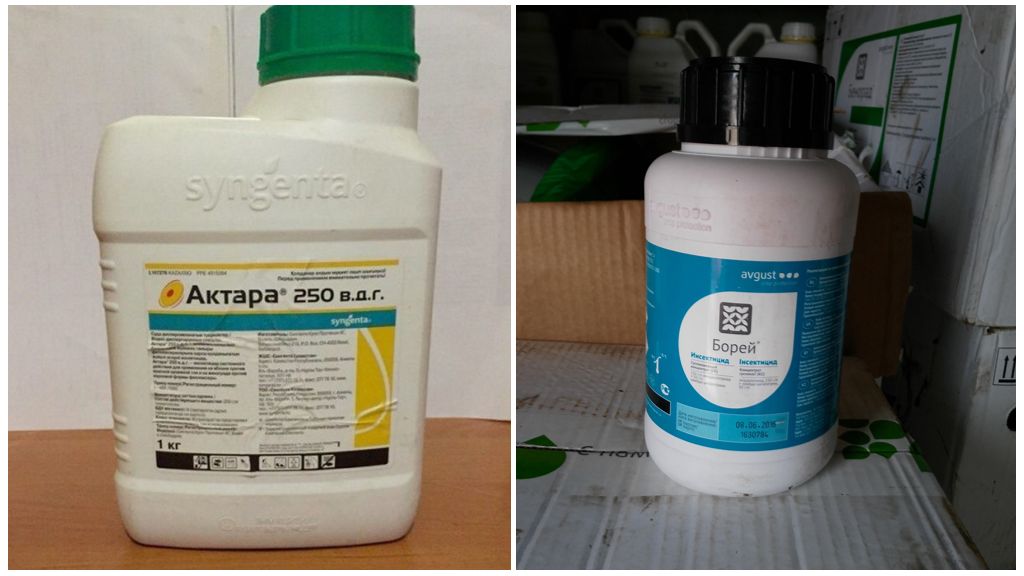How to get rid of carrot flies
Content
- Carrot fly
- Methods of dealing with carrot fly
- Ways to destroy carrot flies
- Carrot Fly Chemicals
Carrot fly is one of the most dangerous pests of root crops, due to its invisibility in the daytime. She goes on a hunt in the morning and evening hours, damaging vegetable crops. To save the crop, you need to know how to deal with a carrot fly. folk or chemical means.
What does a carrot fly look like?
As seen in the photo of a carrot fly, an adult individual looks like a small insect with an elongated body of orange or black color, the belly has greenish-black shades, the wings are almost transparent with yellowish veins, lie horizontally. Its size is not more than 4.5-5 mm. Head yellow mustache, paws of the same color.
Insects spend the winter underground or inside root crops left in the ground, and then fly out with a temperature rise of up to + 15- + 17 ° C, usually in the second half of May. Once warm weather sets in, females of carrot flies lay eggs of milky color near the sown root crops.
The larvae that appeared a few days later are similar to pale yellow worms about 5 mm long. They have no heads and legs, and breathing is carried out through small processes at the posterior end of the body. During the summer season, each female is able to lay up to 120 eggs, doing it regularly for 50 days.
The larvae immediately find their food, gnawing the tender flesh in the carrots and thus harming the garden. There they live for about 3 weeks, gradually growing to 7 mm.Then the larvae move to the soil and pupate.
On a note!
Under favorable conditions, in the second half of summer, the second generation of flies appears, which continues to devour carrots, feeding on its tops and roots. Emerging young females make egg-laying, choosing weedy areas with plants. The maximum activity for the pest is from mid-July to the end of August.
Causes and signs of the appearance of the pest
The ideal conditions for the emergence and reproduction of carrots are heat and humidity. When thickened crops of this culture and excessive watering, the number of larvae increases, causing irreparable damage to the garden.
On a note!
In hot and dry weather, the insect population is sharply reduced due to the death of the egg-laying. But with abundant watering the larvae again begin their vigorous activity.
Each previous generation is looking for favorable places for the appearance of the next, choosing planted garden crops. Favorable conditions and active breeding help the larvae and flies to survive, which feed not only on the green parts of the plant, but also on succulent root crops.If they are not destroyed in time, the harvest will be spoiled.
In order to effectively deal with such a pest, you need to know exactly what the carrot fly looks like and the crops damaged by it.
Signs of carrot damage:
- in root vegetables black dots and moves from the activity of the larvae are visible;
- the pulp is most eaten closer to the bottom of the carrot;
- the tops darken and take on a green-purple hue, then begin to dry: it is better to immediately remove the damaged crop from the ground so that the insects do not switch to neighboring plants;
- due to dysplasia carrots acquire ugly forms;
- if damage is numerous, the plant may die.
On a note!
Carrot flies are parasitic and harm not only on carrot plantings, but also on other root crops: celery, parsley, and sometimes dill. The total yield loss can reach 60-70%.
The main reason for the mass destruction of carrots is the contamination of the plot itself by the pest and its pupae wintering in the soil. If every year crops of a given crop remain in one place, then the number fly larvae and plant damage will increase.Deliverance can bring only a change in the area reserved for carrots.
Methods of struggle
In order to effectively deal with carrot fly in the garden, it is recommended to use various methods:
- agrotechnical, requiring compliance with the rules of crop rotation, sowing carrots every year in a new place, preferably after tomatoes, garlic or onions;
- preventive measures that help to foresee and prevent the contamination of crops;
- folk recipes to help get rid of carrot flies with herbal decoctions and infusions;
- chemical preparations for the treatment of beds and the destruction of pests.
Preventive measures
The following preventive methods are recommended to be used on garden plots in order to protect carrots from pests:
- sow more sugar varieties of carrots resistant to carrot fly: Flaccus, Calgary, Vitamin, Losinoostrovskaya, Olympus, Nantes, etc., which are less susceptible to pest attack;
- choose the optimal place for sowing, which is well ventilated and warming up, because flies, when they fly in search of a place for egg-laying, always choose shaded and wet areas, therefore it is recommended to avoid low-lying and shady areas;
- It is not recommended to make fresh manure in order to fertilize the beds with carrots, but to use such a plot for the next year;
- sowing is often done more densely, in order to thin out, in case of annual damage to crops it is recommended to sow carrots initially more rarely, to apply seeds glued to tape or coated;
- seeds should be pretreated with soil rot agents: Azotofit, Trichodermite, Fitotsid, etc .;
- in the fall, to do a deep digging, carefully turning over large layers of soil, so that the pupae and larvae of the pests would freeze out.
Popular methods of protection against flies
With a small number of pests, it is recommended to fight a carrot fly with folk remedies and protective methods:
- Carrot beds alternate with onion planting, which the smell repels flies.
- Sow at the end of April, before the mass departure of females, and the later ones - in the second half of June and the beginning of July, when the flies are in the pupal stage.
- It is better to cover a sowed bed with a special material (agril, lutrasil, spunbond), which will help prevent laying of eggs.
- To do frequent loosening of row spacing, making sure that the roots of carrots are not laid bare.
- Regularly destroy weeds, weed plants do not leave between the rows.
- Watering carrots should be rare and in small quantities.
- Remove on the garden plot various umbrella cultures that attract flies.
- During the period when females lay their eggs, the rows should be sprinkled with dry mustard, tobacco powder, red or black pepper.
- Another traditional method is the processing of carrots for thinning with kerosene, which is carried out in the appearance phase of 1-3 sheets. Spraying done in sunny weather at the rate of 100 grams of kerosene per 1 square. m, after 2-3 days the weeds die. This old way allows you to destroy small weeds around the sowing of root vegetables, as well as ward off female carrot flies, choosing a place for egg laying.
Recipes of vegetable infusions, which are used for spraying the beds to protect the carrots from pests:
- Onion or garlic infusion is prepared from 300 g of crushed raw materials, which must be poured 2 liters of boiling water, stand for a day. Before you treat carrots from carrot flies, you should add to the solution 10 liters of water and 30 g of liquid or grated household soap.
- It is recommended to spray the beds to scare away flies. aqueous solution of ammonia in the proportion of 50-60 ml per bucket of water.
- Broth from tops of potatoes or tomatoes: add a bucket of water for 4 kg, boil for 30 minutes, leave for 4-5 hours, filter, add 50 g of soap. Before spraying, the solution is diluted in a ratio of 3-5 liters per 10 liters of pure water.
- Infusion of wormwood will help protect carrots for 1 month. It is prepared from fresh chopped greens in 10 liters of boiling water. After insisting, divide the volume into 3 parts, add 8 liters of water to each, then pour the carrots, and put the rest of the grass between the rows.
On a note!
Processing is best done in the morning and evening, in dry weather.
Chemical control agents
The use of strong insecticidal preparations is recommended only with a large contamination of crops. The optimal period to get rid of the pest on carrots is when there is a massive flight of female flies, and the treatment needs to be done not only by sown beds, but also by close-growing weeds.
Important!
Before spraying with chemicals, you should carefully read the instructions for this tool so that the concentration of the working solution is optimal.When using insecticidal preparations, it is necessary to use personal protective equipment: clothing, goggles, respirator, gloves.
Popular insecticidal carrot fly products:
- Aktara is a systemic insecticide, contains thiamethoxam, is produced in the form of granules or suspensions, it infects insects after they eat processed tops or root crops, which makes it possible to fight with fly larvae;
- Borey - designed for monthly processing of crops, consumption is 200 g per 1 liter of water;
- Decis is a universal drug that helps to get rid of harmful insects in the roots of root crops at all stages of development;
- Karate Zeon - used for spraying during the growing season of root crops, before processing a solution of 50 g of the drug and 10 liters of water is prepared;
- Vanteks - used for processing once every 10 days before the end of the vegetative period; Before sprinkling carrots, a solution is prepared: 100 g of the product is diluted with water in a volume of 10 liters;
- Arrivo - concentrated emulsion containing cypermethrin, is prepared at the rate of 20 ml per 10 l of water, it is recommended to process it every 20 days;
- Inta-Vir - available in tablets, each of which is diluted in 10 liters of water, it is recommended to spray carrots during the growing season.
Important!
Harvesting of root crops should be done only if the last treatment with insecticides was carried out more than 3 weeks ago, so as not to get chemical poisoning.
Using an integrated approach to protect the beds of carrots and other root crops from the invasion of carrot fly larvae, which includes preventive efforts and timely treatment against pests, will help grow and preserve the crop.



